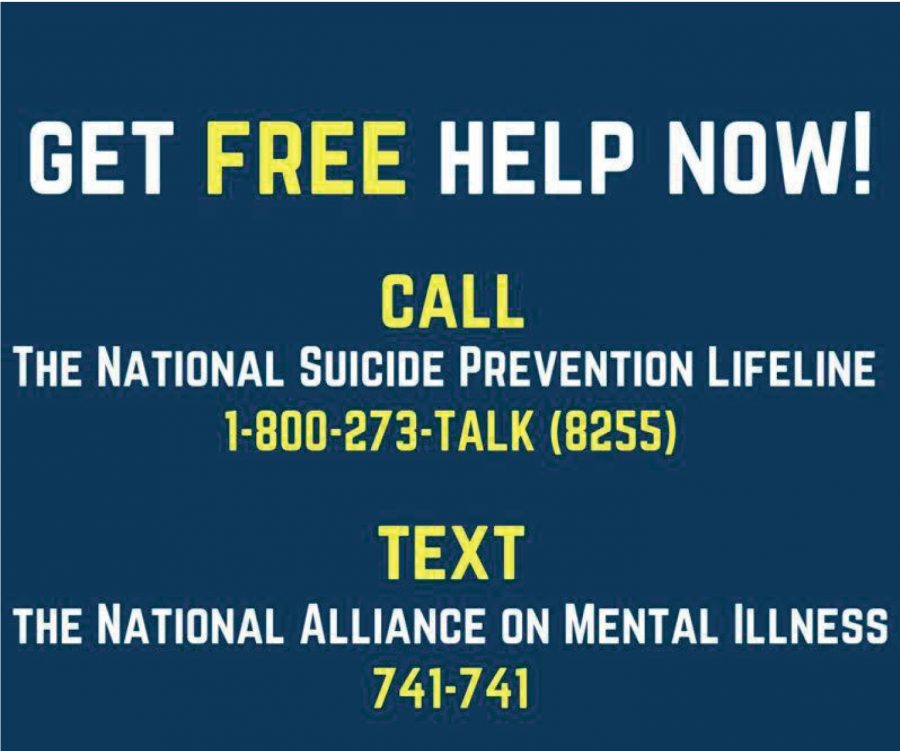Suicide rate rising among teens in U.S.
Please use the phone numbers or text lines if you feel like you need someone to help you.
May 23, 2019
Recently, the rate of teen suicides and attempted suicides have increased in not only the state and nation, but in our town and area. The rapid increase of these losses has affected many of the student body and staff, here at the high school, along with many others in the community.
A few years ago, a student at this school committed suicide. Many of his former classmates attended the funeral, along with much of his family and friends. But his loss affected everyone in the community, especially those he was closest to.
“Well, his death affected me a lot more than anyone really knows. I developed anger issues and anxiety; I have to take anti-psychotics now because I’m so mad all the time,” one of his friends, Ivy, said. “I ended up abusing alcohol and other substances by the time I was seventeen.”
Ivy was close to the student and after his death, she began to abuse alcohol, medication, and other substances. The loss began to absorb her, causing her grades to slip.
“Once I started failing school I didn’t care anymore; I would skip class and sit in the bathroom for hours because being around people made me nauseous,” Ivy said.
With the increase in technology-based issues revolving around cyber bullying, mental illnesses found in teens, and other major contributors to stress, teens across the state have resulted to suicide, our school being no different.
“The pain of losing someone to suicide is so much worse than anyone can imagine. Every day I ask myself, ‘Was I a good enough friend? Did he know how much I loved him? Does he forgive me for not being there enough?’ And I will never get answers to those questions,” Ivy said.
Suicide prevention has been shown through movies, music, and advertisements, making the public aware of the risk and urgency of the problem and how to pursue the situation.
“To recognize that it [suicide] is an issue is probably something that the community, as a whole, can help with-to not push it under the rug, so to speak,” counselor Nancy Lynch said.
In 2008, suicide was ranked tenth as the most common cause of death throughout all ages in the U.S.; it remains there still, today. In 2016, however, suicide became the second most common cause of death for people between the ages 10-34, as well as the fourth most common between the ages 35-54.
Ivy, after the death of her friend, began to spiral down into a pit she could barely escape. With the loss of her friend, she began to develop problems of her own.
“By senior year of high school, I had substance abuse problems, an eating disorder, and multiple mental problems. I weighed about 100 pounds when I was seventeen. I isolated myself from everyone,” she said.
Suicide is common in teens and young adults who suffer from mental illnesses such as depression, bipolar disorder, post-traumatic stress disorder (PTSD), schizophrenia, borderline personality disorder, and others.
Teens who suffer from these disorders, including those who may not realize they have them or do and are too afraid to tell, can become vulnerable to the thought of suicide. Signs of mental illness can vary depending on the illness but many tell-tale signs include drastic mood swings, excessive worrying, social withdraw, insomnia, and others.
“And not one [person] ever realized what was going on. Everyone knew I had lost one of my best friends, but they all thought I was the weird girl just being weird. I felt suffocated,” Ivy said.
People can shy away from the subject of suicide for reasons along the lines of religion, understanding, and the concern that awareness of suicide can lead to copycat suicides. Many believe that if the person in conflict is not confronted then the situation will resolve itself.
“Some people will talk about it and there are some people who are really struggling with asking for help because of the [social] stigma of asking for help. As a community we can realize that it is an issue and maybe take away that some of that stigma,” Lynch said.
Suicide has become a bit of a “touchy subject” but in reality, it’s become a turned shoulder. Suicide rates are constantly climbing and without proper awareness for the situation, they will continue to climb.
“The aftermath of suicide is so much more than what anyone can imagine. If I have anything to say to end this all, it is to please get help,” Ivy said. “I carry his pain with me every single day of my life.”




